Proper hockey skate sizing is crucial for performance and comfort. Skates typically fit 1-1.5 sizes smaller than shoe size. Use sizing guides for accurate fit, ensuring energy transfer and protection.
Understanding the Importance of Proper Skate Fit
A proper skate fit is essential for performance, comfort, and injury prevention. Ill-fitting skates can lead to discomfort, blisters, and reduced control on the ice. A snug fit ensures optimal energy transfer, stability, and protection. Skates that are too tight or too loose can hinder skating efficiency and increase the risk of injuries. Proper fit also enhances agility and responsiveness, allowing players to perform at their best. Ensuring the right size and comfort is critical for both competitive and recreational hockey players.

How Hockey Skate Sizing Relates to Shoe Size
Hockey skates typically fit 1-1.5 sizes smaller than regular shoe sizes. Use a size chart to ensure accuracy, as brands may vary slightly in sizing standards.
Senior Skate Sizing
Senior hockey skates are designed for adult players and typically fit 1.5 sizes smaller than a men’s shoe size. Proper fit ensures optimal performance and comfort during the game.
Junior and Youth Skate Sizing
Junior and youth hockey skates are designed for younger players, typically fitting 1 size smaller than their shoe size. Proper sizing ensures optimal performance and comfort, allowing for better energy transfer and protection. It’s essential to consult size charts for accuracy, as sizes can vary slightly between brands. Correct fit helps young players maintain control and confidence on the ice, making their skating experience more enjoyable and effective.

Measuring Your Foot for Accurate Skate Size
Measuring your foot length while standing provides accurate skate sizing. Use a ruler or measuring tape to determine your size, ensuring a proper fit.
Method for Measuring Foot Length
To measure your foot length accurately, place your foot against a wall while standing. Use a ruler or measuring tape to record the distance from the heel to the tip of the longest toe. Ensure the foot is flat on the floor for precise measurement. This method helps determine the correct skate size, ensuring comfort and performance on the ice.
Tools Needed for Measurement
To accurately measure your foot length, you’ll need a ruler, measuring tape, or a flat, hard surface like a wall. Place your foot against the wall, ensuring it’s flat on the floor. Measure the distance from the back of the heel to the tip of the longest toe. For precision, wear the same type of socks you’ll use when skating. This setup ensures an accurate measurement, helping you find the perfect skate size for comfort and performance.
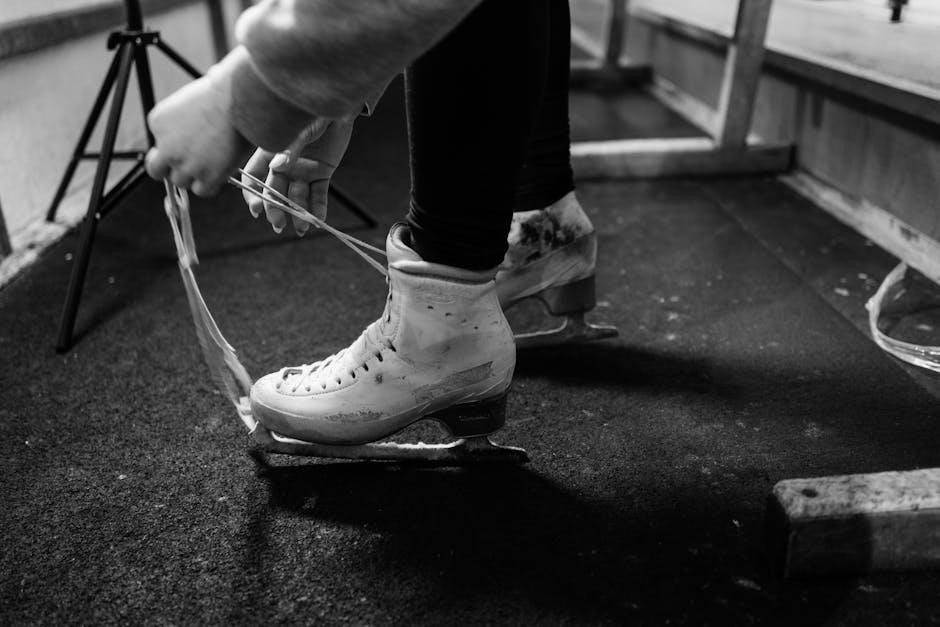
Proper Fit Characteristics for Hockey Skates
A proper fit ensures snugness, support, and comfort. Your toes should barely touch the toe cap, with minimal heel movement. The skates should feel secure, not overly tight, providing stability for optimal performance on the ice.
Toe Space and Comfort
Proper toe space ensures your toes lightly touch the skate’s toe cap, allowing minimal wiggle room without compression. Excessive space can reduce control, while tightness may restrict circulation and lead to discomfort. Ensure a snug fit where toes can move slightly up and down but not side to side. This balance prevents blisters and enhances skating performance. Proper fit in the toe box is essential for comfort and responsiveness on the ice.
Heel Fit and Stability
A proper heel fit ensures minimal movement and maximum stability. The heel should fit snugly, with no more than 1/4 inch of space between the heel and the skate. This prevents sliding during skating, which can cause discomfort and affect performance. A secure heel fit enhances energy transfer and control, allowing for precise movements on the ice. Proper heel stability is crucial for maintaining balance and responsiveness during gameplay.
Overall Snugness and Support
A proper fit ensures the skate feels snug but not overly tight, providing consistent support. The boot should mold to the foot, preventing excessive movement while maintaining circulation. Proper snugness enhances performance, allowing for precise control and quick maneuvers. The skate’s structure should provide lateral stability and ankle support, crucial for sharp turns and explosive acceleration. A well-supported fit reduces fatigue and enhances comfort, ensuring peak performance during gameplay.
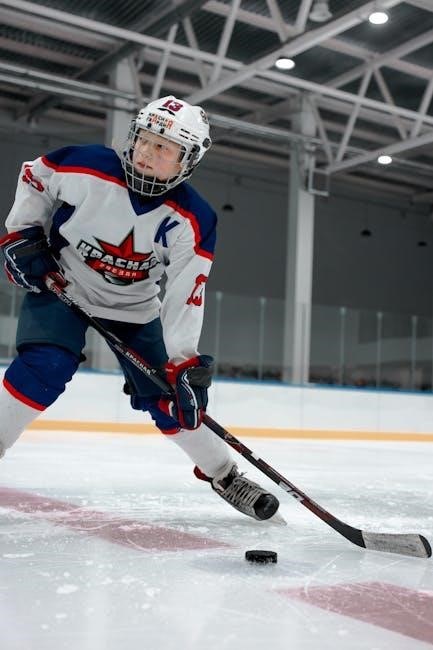
Differences in Sizing Between Ice and Inline Hockey Skates
Ice hockey skates typically fit tighter, sizing 1.5 sizes smaller than shoe size, while inline skates offer a slightly more forgiving fit, usually 1 size smaller.
Ice Hockey Skate Fit
Ice hockey skates typically fit 1.5 sizes smaller than your regular shoe size. To ensure a proper fit, measure your foot length and consult the brand’s sizing chart. Your toes should barely touch the toe cap, with no more than 1/4 inch of space in the heel. The skates should feel snug when laced, providing support and stability. Proper fit is essential for performance, as it allows for better energy transfer and maneuverability on the ice.
Inline Hockey Skate Fit
Inline hockey skates generally fit closer to your shoe size compared to ice skates. Choose a size that allows your toes to touch the cap with minimal space, ensuring comfort and control. Proper fit is key for stability and performance during gameplay. Measure foot length and consult brand charts for accuracy. Snugness without tightness is ideal for optimal movement and support.
Hockey Skate Sizing Charts
Hockey skate sizing charts provide detailed size conversions for senior, junior, and youth skates. Ensure accurate fit and optimal performance by consulting brand-specific charts.
Senior Skate Size Chart
Senior hockey skate sizes cater to adults and larger teenagers, typically fitting 1.5 sizes smaller than shoe size. Charts list US, European, and UK sizes with corresponding centimeter measurements. They help match shoe size to skate size for accuracy. Proper fit ensures optimal performance and comfort, with snugness around the foot and minimal toe movement. Consult brand-specific charts for precise sizing, as variations exist. Correct fit enhances skating efficiency and reduces discomfort during gameplay.
Junior and Youth Skate Size Chart
Junior and youth skate charts are designed for younger players, fitting 1 size smaller than shoe size. These charts list US, European, and UK sizes with centimeter measurements, ensuring proper fit for growing feet. They help determine the right size based on foot length, providing comfort and support. Correct sizing is essential for young skaters to maintain balance and performance. Always refer to brand-specific charts for accurate measurements and a comfortable fit.
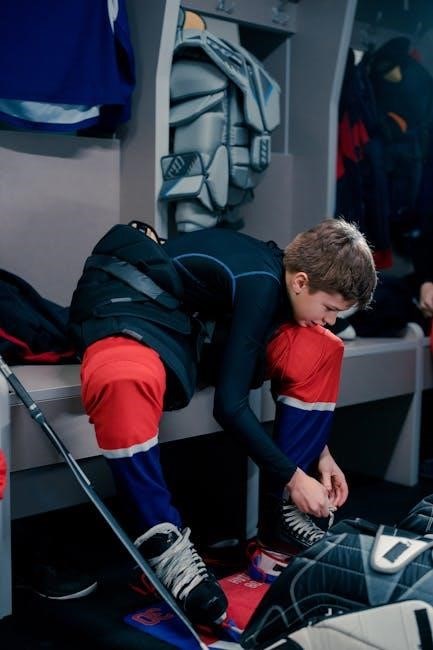
Factors Affecting Skate Size
Skate width and brand-specific sizing significantly affect fit, ensuring comfort, performance, and support for players of all levels and preferences, crucial for optimal skating.
Skate Width Options
Skate width options vary, with narrower widths offering better support for slimmer feet and wider widths accommodating broader feet. Proper width ensures a snug fit, enhancing stability and agility. Different brands provide specific widths to cater to various foot shapes and skating styles, ensuring comfort and optimal performance. Choosing the right width is crucial for maximizing skating efficiency and preventing discomfort during play.
Brand-Specific Sizing Differences
Brand-specific sizing differences play a significant role in hockey skate fit. For instance, Bauer skates may fit slightly roomier in the toe box compared to CCM, which often offers a snugger heel fit. Brands like True Hockey and Warrior also have unique sizing profiles. Always consult the brand’s size chart, as variations exist between manufacturers. Proper fit depends on both foot shape and brand-specific design, ensuring optimal performance and comfort during gameplay.
Trying On Hockey Skates
Try hockey skates in the afternoon, as feet tend to swell. Wear the same socks you’ll use for skating. Lace up properly to ensure snugness and support.
Best Time to Try On Skates
The ideal time to try on hockey skates is in the afternoon or evening when feet are at their largest due to natural swelling. This ensures a more accurate fit. Wear the same type of socks you plan to use while skating to simulate real conditions. Proper lacing and a snug fit are essential for performance and comfort on the ice. Trying skates at the right time enhances the overall fitting experience.
What to Wear When Fitting Skates
When fitting hockey skates, wear the same type of socks you plan to use while skating. Thin, moisture-wicking socks are recommended to keep feet dry and comfortable. Avoid bulky socks as they can affect fit and performance. Some players also use a thin liner sock for added comfort. Wearing the right attire ensures an accurate fit and helps in assessing the skate’s comfort and support during the try-on process.
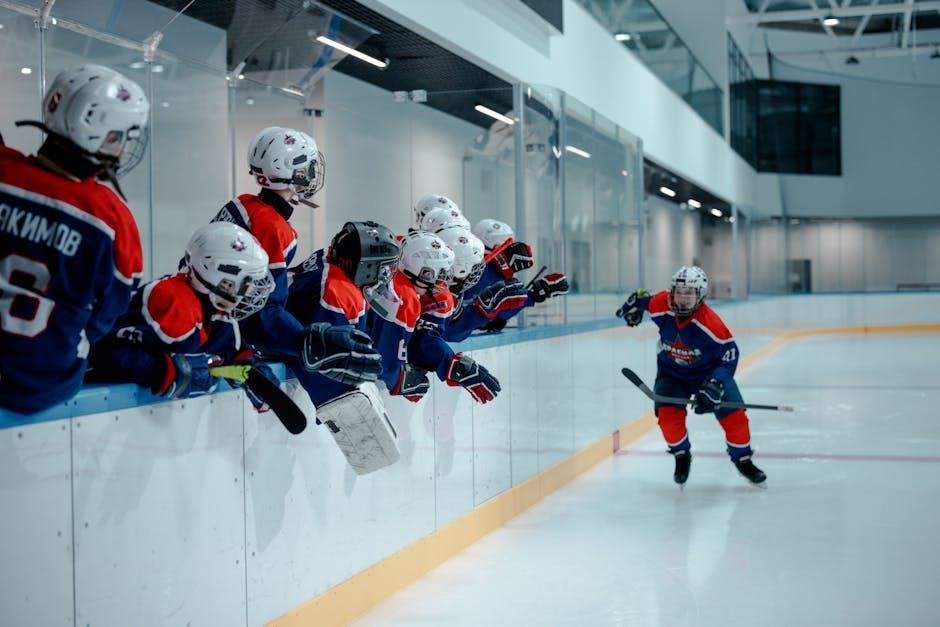
Customizing Your Skate Fit
Customizing your hockey skates enhances comfort and performance. Baking skates molds them to your feet, while heat-moldable options offer a tailored fit for optimal support and responsiveness.
Baking Hockey Skates
Baking hockey skates is a popular customization method to achieve a precise fit. The process involves heating the skates in an oven to soften the material, allowing them to mold around your feet. This technique ensures optimal support, reduces break-in time, and enhances comfort. Proper temperature and timing are crucial to avoid damaging the skates. Many brands offer bakeable models, making this a recommended step for serious players seeking a tailored fit.
Heat Moldable Skate Options
Heat moldable skates offer a customizable fit by shaping the boot around your foot using heat. This process enhances comfort and performance, reducing break-in time. Many high-end brands provide this feature, allowing precise adjustments to accommodate foot shape and skating style. Proper heating techniques are essential to avoid damage. Moldable skates are ideal for players seeking a tailored fit, ensuring maximum support and responsiveness on the ice.
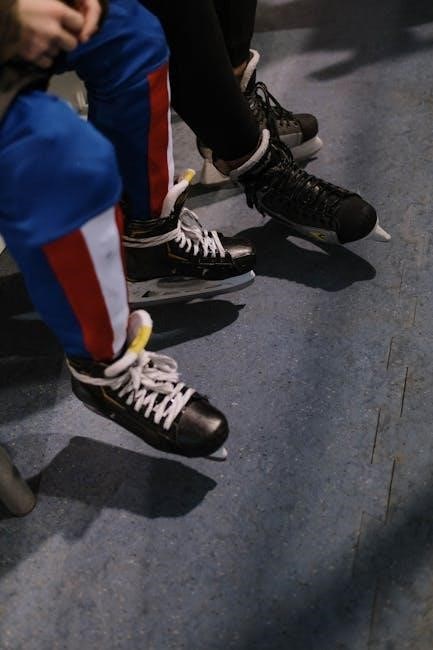
Hockey Skate Lace Length Sizing
Proper lace length ensures a snug, secure fit without excess material. Use a sizing chart to match your skate size with the ideal lace length for optimal performance and safety.
Importance of Proper Lace Length
Proper lace length is essential for optimal performance and safety. Correct lacing ensures a snug fit, preventing blisters and improving stability. Excess lace can cause tripping hazards, while too little may restrict movement. Different skating styles, such as aggressive or recreational, may require varying lace lengths. Always consult a sizing chart to match your skate size with the ideal lace length for your needs, ensuring comfort and control during gameplay or practice.
Lace Length Sizing Chart
A hockey skate lace length sizing chart helps determine the ideal lace length based on skate size. Typically, lace lengths range from 120mm for smaller skates (youth sizes) up to 210mm for larger skates (senior sizes). The chart provides a guideline, ensuring proper fit and performance. However, lace lengths can vary slightly between brands, so it’s best to consult the specific brand’s sizing chart for accuracy. Proper lacing enhances skating efficiency and comfort.
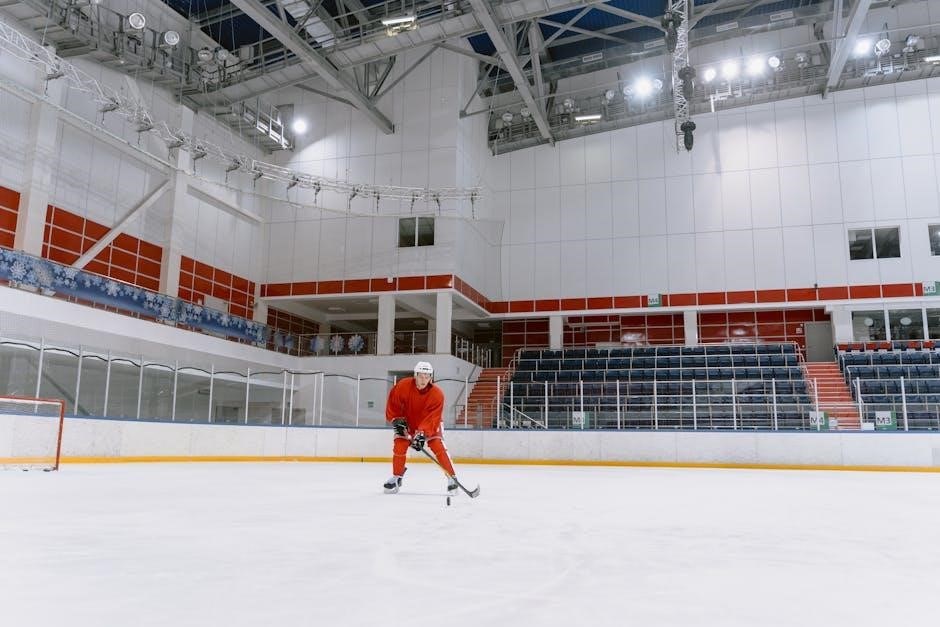
Common Mistakes to Avoid
Avoid choosing skates too small or large. Ensure proper fit by measuring foot length and consulting size charts. Don’t overlook differences between ice and inline skates.
Overlooking Size Differences
Many players overlook size differences between brands and skate types. Senior skates are 1.5 sizes smaller than shoe size, while junior/youth skates are 1 size down. Ignoring these distinctions can lead to poor fit, affecting performance and comfort. Always refer to brand-specific charts, as sizing varies. Proper fit ensures optimal support and energy transfer, crucial for any player’s game. Consulting sizing guides helps avoid common mistakes and ensures the best fit.
Not Considering Skate Type
Players often overlook how skate type impacts sizing. Ice hockey skates and inline skates differ in fit and design. Ice skates have a more snug fit, while inline skates may offer a bit more room. Additionally, goalie skates differ from player skates in width and support. Failing to consider these differences can result in improper fit, reducing performance and comfort. Always choose the correct skate type for your needs and check specific sizing charts to ensure the best fit and functionality.
Proper hockey skate sizing enhances performance, comfort, and safety. Measure accurately, consult charts, and consider skate type for the best fit. Happy skating!
Final Tips for the Best Fit
Ensure your skates fit snugly, with toes barely touching the cap and minimal heel space. Try them on with skating socks and lace properly for support. Consider baking or heat molding for a custom fit. Check brand-specific sizing charts, as variations exist. Test skates during late afternoon for accurate sizing, as feet swell throughout the day. Prioritize comfort and stability to maximize performance and enjoyment on the ice.
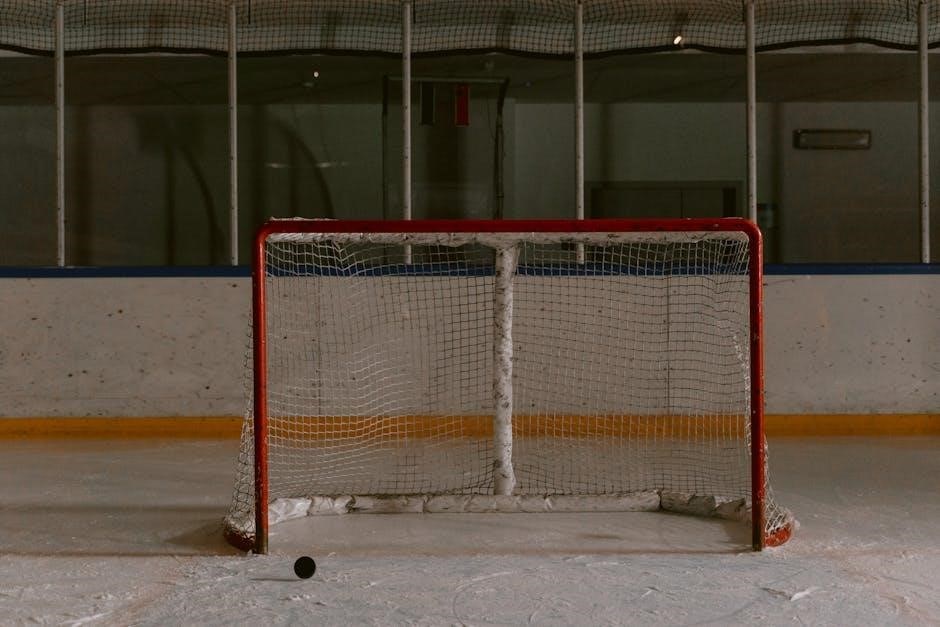
Additional Resources
Consult brand-specific sizing tools for precise fit. Explore guides from Bauer, CCM, and True Hockey for detailed charts and customization tips to enhance your skate fitting experience.
Recommended Skate Fitting Guides
For accurate sizing, refer to guides from top brands like Bauer and CCM. These resources provide detailed charts, measurement tips, and customization options. Visit True Hockey for comprehensive fitting advice, ensuring optimal performance and comfort. Always measure feet and consider skate type and brand variations for the best fit. These guides help you make informed decisions, whether you’re a pro or just starting out.
Brand-Specific Sizing Tools
Brands like Bauer and CCM offer custom sizing tools online. Bauer’s Fit Finder and CCM’s Size Guide provide personalized recommendations. These tools use shoe size and foot measurements to suggest ideal skate sizes. Some brands even offer 3D foot scanners for precise fits. Utilize these resources to ensure accuracy and comfort, tailored to your specific needs and skating style.
